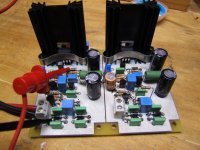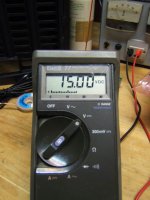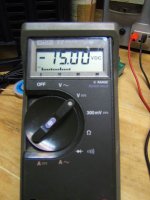KRO
You wrote you had some transformers ?
Do you have any spare ones you can miss?
Or do you have a good and cheap address in the south of the Netherlands?
Thanks for answering,
Dick.
You wrote you had some transformers ?
Do you have any spare ones you can miss?
Or do you have a good and cheap address in the south of the Netherlands?
Thanks for answering,
Dick.
Dick,
The transformer has two 110V primaries, so you in 220 land can wire them in series, while we choose parallel.
Shipping could be expensive, though. There is no USPS flat rate international box that I've been able to find. THere is one for US domestic use that will hold several. While a couple would fit in the Flate Rate GPM envelope, that doesn't seem like the smartest thing to do if you want it to actually arrive.
The transformer has two 110V primaries, so you in 220 land can wire them in series, while we choose parallel.
Shipping could be expensive, though. There is no USPS flat rate international box that I've been able to find. THere is one for US domestic use that will hold several. While a couple would fit in the Flate Rate GPM envelope, that doesn't seem like the smartest thing to do if you want it to actually arrive.
I was asked in the OPA2134 buy thread if I would consolidate orders for overseas shipments for opamps, PSU boards/kits, etc. and filter boards.
For those who would like to consolidate their orders for opamps, filter boards, heat sinks and psu boards/kits into one package, let me know. I will calculate postage and let you know what total shipping costs will be. There is a risk that it will be higher than a few smaller flat rate envelopes. I will NOT ship transformers in an envelope.
Within the US there is the flat rate box for around $8.50 (check the website), so you might save a little.
I have all paid filter boards wrapped and in envelopes waiting shipping labels/postage. Unless I hear from you by noon EST (GMT-5) Sunday March 26th that you want me to hold your order, I will ship it Monday.
Filter board GB round 2 is open...
For those who would like to consolidate their orders for opamps, filter boards, heat sinks and psu boards/kits into one package, let me know. I will calculate postage and let you know what total shipping costs will be. There is a risk that it will be higher than a few smaller flat rate envelopes. I will NOT ship transformers in an envelope.
Within the US there is the flat rate box for around $8.50 (check the website), so you might save a little.
I have all paid filter boards wrapped and in envelopes waiting shipping labels/postage. Unless I hear from you by noon EST (GMT-5) Sunday March 26th that you want me to hold your order, I will ship it Monday.
Filter board GB round 2 is open...
I received the prototype boards today. They are on the way to Jens for testing. Minus silkscreen and soldermask they aren't pretty. Full up prototypes would have cost $400+, these only cost $75 for 5.
I'll build up one and verify that it works, but other than sticking my scope on the output, I cannot properly test it.
I'll build up one and verify that it works, but other than sticking my scope on the output, I cannot properly test it.
If you are doing a 3 way, with 2 active filter boards per side, ie 4 boards, how many PSU/ regulator boards are needed?
(Dumb question) if all in one box, just one? ~
And Bob,
you referred to Jens' documentation as more helpful than Don Lancaster’s book (which I have, it’s ok) – can we see this documentation, to start to get our head around it better?
Thanks
(Dumb question) if all in one box, just one? ~
And Bob,
you referred to Jens' documentation as more helpful than Don Lancaster’s book (which I have, it’s ok) – can we see this documentation, to start to get our head around it better?
Thanks
One PSU can deliver over an amp with the heat sinks available on the WIKI. Four filter boards fully stuffed will draw about 320 mA. With a 15V transformer (-> ~20.4 VDC), and 1 ohm in the CRC, the pass devices will drop about 5V, dissipating 1.5W. The pass devices must have heat sinks over 1W. While they don't need the ones gengis is offering, for ~$.50 more than adequate heat sinks, why not go large?
Many will suggest that you go dual mono, use one PSU per channel, all the way back to two transformers. A compromise would be share a transformer but use separate regulators. There is likely to be little if any communication between channels back through the regulators.
Jens' documentation is on his website www.delta-audio.com look under kits and modules, then active filters. These boards are similar in topology to a pair of active filter twos strung together. There aren't as many jumpers, but it gives you an idea about the basic filter design.
I find Jens' approach to the math more user friendly when you just want to design a filter - especially if your goal falls between Lancaster's recipes. I could never work through Lancaster far enough to come up with a spreadsheet, but was able to with Jens' guide.
See Jens' active filter one for notch and peak EQ.
I'm expanding on the possibilities with the input buffer, adding the Linkwitz transform and all pass sections. I will also discuss Cauer-Elliptic filters and show a couple of design examples. I have a couple of long airport layovers the next few days, I might just get the thing done.
Many will suggest that you go dual mono, use one PSU per channel, all the way back to two transformers. A compromise would be share a transformer but use separate regulators. There is likely to be little if any communication between channels back through the regulators.
Jens' documentation is on his website www.delta-audio.com look under kits and modules, then active filters. These boards are similar in topology to a pair of active filter twos strung together. There aren't as many jumpers, but it gives you an idea about the basic filter design.
I find Jens' approach to the math more user friendly when you just want to design a filter - especially if your goal falls between Lancaster's recipes. I could never work through Lancaster far enough to come up with a spreadsheet, but was able to with Jens' guide.
See Jens' active filter one for notch and peak EQ.
I'm expanding on the possibilities with the input buffer, adding the Linkwitz transform and all pass sections. I will also discuss Cauer-Elliptic filters and show a couple of design examples. I have a couple of long airport layovers the next few days, I might just get the thing done.
I think I'll go for 2 PSU boards after all (good suggestion, Bob).
When using 1 PSU per filterboard I wouldn't have to use a heat sink?
Can I still change the WIKI?
Dick.
When using 1 PSU per filterboard I wouldn't have to use a heat sink?
Can I still change the WIKI?
Dick.
With 2 boards per psu you can get away without a heatsink. Figure 0.4W dissipated in the PSU per board. You can go up to 1W or so without a heatsink.
Go ahead and update the WIKI. Closing date is April 14th.
Go ahead and update the WIKI. Closing date is April 14th.
Use heat sinks
Testing has shown the need to use a higher voltage transformer. With a 15VAC transformer, the bottom of the ripple was low enough that there was not enough voltage left for the regulator to work with and some ripple showed up on the output.
For 15 volt operation, we recommend an 18VAC transformer. The group buy transformer will have dual 18V secondaries.
This choice, like all engineering choices, has other consequences. The biggest impact for us is increasing the power dissipated in the pass devices.
For reliability we now recommend using heat sinks for virtually all applications.
Testing has shown the need to use a higher voltage transformer. With a 15VAC transformer, the bottom of the ripple was low enough that there was not enough voltage left for the regulator to work with and some ripple showed up on the output.
For 15 volt operation, we recommend an 18VAC transformer. The group buy transformer will have dual 18V secondaries.
This choice, like all engineering choices, has other consequences. The biggest impact for us is increasing the power dissipated in the pass devices.
For reliability we now recommend using heat sinks for virtually all applications.
Parts Choices
Jens will be posting a (slightly) revised layout and BOM for 15V output once he finishes his pizza. Jens' BOM will show green LEDs and voltage setting resistor values that reflect the use of a trim pot.
Questions for the group:
1. Are green LEDs acceptable (low cost) or would you prefer another color? Blue LEDs would be one of the most expensive items in the BOM.
2. Trim pots again. For active filter board operation trip pots are not absolutely needed, but voltages could be off a little due to component tolerances. Trim pots would be the most expensive item in the BOM. Do we want them in the parts kit?
The Epcos 1 uf caps wil not be available at Digikey until mid May. This should not delay shipment much, if at all. this could be the schedule driver.
Jens will be posting a (slightly) revised layout and BOM for 15V output once he finishes his pizza. Jens' BOM will show green LEDs and voltage setting resistor values that reflect the use of a trim pot.
Questions for the group:
1. Are green LEDs acceptable (low cost) or would you prefer another color? Blue LEDs would be one of the most expensive items in the BOM.
2. Trim pots again. For active filter board operation trip pots are not absolutely needed, but voltages could be off a little due to component tolerances. Trim pots would be the most expensive item in the BOM. Do we want them in the parts kit?
The Epcos 1 uf caps wil not be available at Digikey until mid May. This should not delay shipment much, if at all. this could be the schedule driver.
- Status
- Not open for further replies.
- Home
- Group Buys
- Scalable PSU/regulator GB



 and now you have to put it out for hardship and misery.
and now you have to put it out for hardship and misery. 







